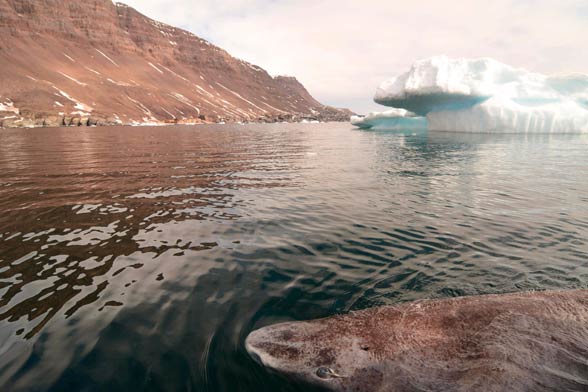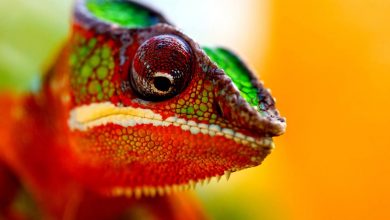Greenland shark (Somniosus microcephalus)
The longest-living vertebrate
It is said that the human organism is programmed to live 120 years. Most of us think it is almost impossible. However, 120 years are few in comparison to the capabilities of other creatures living on Earth. Fish, tortoises or marine mammals can live longer than us. Not to mention sponges (Scolymastra joubini) that live 15 thousand years, or the immortal jellyfish.
Now we can add the real record-breaker among vertebrates to this group – the Greenland shark that is described in this article. Let’s learn the history of the longest-living vertebrate in the world, and one of the slowest sharks.
Classification
- Kingdom: Animalia
- Phylum: Chordata
- Class: Chondrichthyes
- Order: Squaliformes
- Family: Somniosidae
- Genus: Somniosus
- Species: Somniosus microcephalus
- Names: Greenland shark, gurry shark, grey shark, polar shark, eqalussuaq

Occurrence
Northern regions of the Atlantic Ocean, the White Sea, and the Arctic Ocean are the places where you can find the Greenland shark. Its organism is adapted to living in deep waters, and the shark takes advantage from it. The sharks of this species have been found at a depth of 2,200 m (7,200 ft)), although they usually swim a bit higher in the water – at about 1,200 m (3,940ft) deep.
In August 2013, researchers from the Florida State University captured the first documented Greenland shark. It took place in the Gulf of Mexico. The shark was swimming at a depth of 1,749 m (5,738ft) where water temperature was 4.1oC (39℉).

Characteristics
The Greenland shark is characterized by a short, rounded snout, small eyes, and very small pectoral and dorsal fins. The gill slits also seem to be disproportionally small in comparison to the size of the animal. The skin is creamy-grey or blackish-brown. Colors usually mix together, but in some sharks, you can find white spots or dark streaks.
The upper teeth are very thin and spiky. They work as an anchor that grabs prey into the mouth. The lower teeth are wide, square, and nodular, and their main task is to portion food.
The Greenland shark competes with its cousin of the Somniosus pacificus species to be the largest representative of the Somniosidae family. Moreover, it is considered one of the largest living sharks. Being a little smaller than the great white shark, it reaches 2.4-4.8 m (8.0–15.7 ft) of length and 400 kg (880 lb) of weight. The largest recorded individuals may be 6 meters (19ft 8in) long and weigh over a tonne (2,200 lb). Males are usually smaller than females.

Diet
As the leading predator, the shark can allow itself to hunt almost every fish. It feeds on smaller sharks, skates, eels, herrings, flounders, wolffish, and marine mammals of the size of the seal. The remains of polar bears, moose, reindeer, and horses have also been found in their stomachs.
The shark is considered a scavenger that is sensitive to the smell of rotting meat. Greenland sharks often gather around fishing vessels, which is caused by a strong smell of fish coming from the board.

Lifestyle
The Greenland shark moves slowly and steadily. It is capable of the speed of about 1 km/h (0.62 mph), it can accelerate to over 2.5 km/h (1.6 mph). It makes the shark one of the slowest sharks. Its maximum speed is half as low as the speed of an average seal.
So how Greenland sharks hunt for animals larger than them? Scientists suspect that they attack their prey while it sleeps.

Once upon a time…, a few words about longevity
It has been believed that the bowhead whale is the longest living vertebrate in the world. Its longevity cannot be denied – it can live over 200 years. However, there are indications that the Greenland shark lives 200 years longer.
The issue of the longevity of deep-sea animals was raised by biologists in the 1930s. Based on observations of 400 marked sharks they concluded that local sharks grew by merely 1 cm per year. Bearing in mind that Greenland sharks can be 6 m long, they were deemed to must have lived very long to reach their size.
However, it has never been possible to analyze how long. Fortunately, due to radiocarbon dating, we are closer to discovering the life expectancy of these sharks (this subject has been already discussed in the article: Sharks – myths and facts). By using this method of dating, in 2016, it was calculated that Greenland sharks live minimum 120 years, and their maximum life expectancy may even reach 512 years (392 ± 120). If the calculations were accurate, it would also turn out that the sharks reach their sexual maturity only at the age of 150 years.

The life expectancy of Greenland sharks was also attempted to be calculated on the basis of characteristic calcification on pectoral fins that have a similar function to growth rings in the trunks of trees.
However, this method does not apply to our protagonists, because they do not have these hard bone structures. The most relevant way of calculating the life expectancy of a given individual is at the same time not very subtle and morally doubtful.
Because in order to learn how old a given shark is, you need to take its eye lenses, which contain some information, and, additionally, the inactive parts of the eye lens are cyclically replaced with new ones. By detaching a layer of the eye lens, you can reach an element that “remembers” the shark’s period of youth. On its basis, the age of the examined animal may be determined.

Eating out… the eyes
In many pictures, you can notice parasites attached to Greenland sharks’ eyes. Observations showed that most sharks have parasites. These parasites are copepods (Copepoda), and, to be more accurate, Ommatokoita elongata eating out the shark’s cornea, which leads to poorer vision or its complete loss. These parasites are usually about 3 cm long, and females are the one that attach themselves to the shark’s eyes. What is interesting, sharks that do not have any parasites are rare.
A demon in depths…
Because copepods glow in the dark, Greenland sharks look somewhat demonic when they have a green glow in their eyes in a deep ocean. It also has its good side – small fish and other marine animals, lured by the glow, become the prey of the shark.

Detailed information / size
Greenland shark (Somniosus microcephalus)
- Body length: 2.44-4.8 m (8 ft – 15ft 9 in) on average, maximum known length 6.4 m (20ft 12in), maximum possible length 7.3 m (23ft 11in)
- Weight: 400 kg (882 lb) on average, maximum known weight 1,000 kg (2,205 lb), maximum possible weight 1,400 kg (3,086 lb)
- Lifespan: 120-392 years (maximum 400-512 years)
- Diving depth: to 2,200 m (7,200 ft)
- Preferred temperature: −0.6 to 12 °C (31 – 54℉)
Greenland shark – interesting facts
- The tissues of the Greenland shark contain high concentration of an organic compound called TMAO. It makes the meat toxic. However, it does not bother Icelandic cooks. One of Iceland’s dishes is Kćstur hákarl – the shark’s meat is processed so that the toxins are reduced.
- In Icelandic, Kćstur hákarl may be translated as “healed shark”.



















